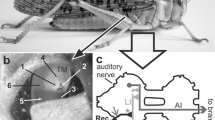Summary
-
1.
Threshold currents as function of temperature were determined on the isolated Lorenzinian ampullae of the dogfish. Currents were applied via microelectrodes in the orifice of the ampullary canal. Response frequencies of single afferent units were averaged for at least 100 successive identical stimulus pulses by means of autocorrelation functions and periodograms. The threshold was defined by a 10% change of response frequency caused by the stimulus.
-
2.
The lowest threshold current for the single ampulla was found to be about 0.01 nA at temperatures between 13 °C and 19 °C. This current corresponded to a current density of ca. 8 nA/cm2, or to a potential difference of 2 μV between the ampullary canal and the grounded exterior.
-
3.
There was a strong temperature dependence of electrosensitivity of the ampulla: the threshold currents increased with lower (7 °C) and higher temperatures (25 °C) by a factor of about 10.
-
4.
The threshold currents found by computer averaging were smaller by a factor of at least 10 than those given up to now for the single isolated ampulla, and corresponded well to the values estimated in behavioural experiments on the living animal. This fact might be explained by spatial summation in the electrosensory system.
Similar content being viewed by others
References
Akoev, G.N., Ilyinsky, O.B.: Some functional characteristics of the electroreceptors (ampullae of Lorenzini) of elasmobranchs. Experientia (Basel)29, 293–294 (1973)
Akoev, G.N., Ilyinsky, O.B., Zadan, P.M.: Responses of electroreceptors (Ampullae of Lorenzini) of skates to electric and magnetic fields. J. comp. Physiol.106, 127–137 (1976)
Barlow, H.B., Levick, W.R.: Three factors limiting the reliable detection of light by retinal ganglion cells of the cat. J. Physiol. (Lond.)200, 1–24 (1969)
Bennett, M.V.L.: Electroreception. In: Fish physiology (W.S. Hoar, D.J. Randall, ed.), Vol. 5, pp. 493–547. New York: Academic Press 1971
Bromm, B., Hensel, H., Nier, K.: Responses of the ampullae of Lorenzini to static combined electric and thermal stimuli inScyliorhinus canicula. Experientia (Basel)31, 615–618 (1975)
Bullock, T.H.: Seeing the world through a new sense; electroreception in fish. Amer. Sci.61, 316–325 (1973)
Dijkgraaf, S., Kalmijn, A.J.: Verhaltensversuche zur Funktion der Lorenzinischen Ampullen. Naturwissenschaften49, 400 (1962)
Fühner, H.: Speisungsflüssigkeit für Selachierherzen. J. allg. Physiol.8, 485–492 (1908)
Heiss, W.D., Milne, D.C.: Single fibres of cat optic nerve: “threshold” to light. Science155, 1571–1572 (1967)
Hensel, H.: Quantitative Beziehungen zwischen Temperaturreiz und Aktionspotentialen der Lorenzinischen Ampullen. Z. vergl. Physiol.37, 509–526 (1955)
Kalmijn, A.J.: Electroreception in sharks and rays. Nature (Lond.)212, 1232–1233 (1966)
Kalmijn, A.J.: The electric sense of sharks and rays. J. exp. Biol.55, 371–383 (1971)
Kalmijn, A.J.: The detection of electric fields from inanimate and animate sources other than electroorgans. In: Handbook of sensory physiol., Vol. III/3, (Fessard, A., ed.), pp. 147–200 Berlin-Heidelberg-New York: Springer 1974
Lissmann, H.W., Machin, K.E.: The mechanism of object location inGymnarchus niloticus and similar fish. J. exp. Biol.35, 451–486 (1958)
Lissmann, H.W., Machin, K.E.: Electric receptors in a non electric fish (Ciarias). Nature (Lond.)199, 88–89 (1963)
Murray, R.W.: The response of the ampullae of Lorenzini to combined stimulation by temperature change and weak direct currents. J. Physiol. (Lond.)145, 1–13 (1959)
Murray, R.W.: The response of the ampullae of Lorenzini of elasmobranchs to electrical stimulation. J. exp. Biol.39, 119–128 (1962)
Murray, R.W.: Electroreceptor mechanisms: The relation of impulse frequency to stimulus strength and responses to pulsed stimuli in the ampullae of Lorenzini of elasmobranchs. J. Physiol. (Lond.)180, 592–606 (1965)
Obara, S., Bennett, M.V.L.: Mode of Operation of Ampullae of Lorenzini of the Skate,Raja. J. gen. Physiol.60, 534–557 (1972)
Rommel, S.A., McCleave, J.D.: Oceanic electric fields: perception by American eels. Science176, 1233–1235 (1972)
Sand, A.: The function of the ampullae of Lorenzini with some observations on the effect of temperature on sensory rhythm. Proc. roy. Soc. B125, 124–533 (1938)
Waltman, B.: Electrical properties and fine structure of the ampullary canals of Lorenzini. Acta physiol. scand., Suppl.264, 1–60 (1966)
Author information
Authors and Affiliations
Additional information
A preliminary report was given by Bromm, Hensel, and Tagmat 1975
Supported by the Deutsche Forschungsgemeinschaft
The experiments were performed at the Biologische Anstalt Helgoland. We wish to thank Prof. Dr. O. Kinne for his hospitality and support, Mr. J.-K. Holtmann for his help during the adaptation procedure, and Mrs. v. Rehren and Miss Walter for technical assistance.
Rights and permissions
About this article
Cite this article
Bromm, B., Hensel, H. & Tagmat, A.T. The electrosensitivity of the isolated ampulla of lorenzini in the dogfish. J. Comp. Physiol. 111, 127–136 (1976). https://doi.org/10.1007/BF00605528
Received:
Issue Date:
DOI: https://doi.org/10.1007/BF00605528



